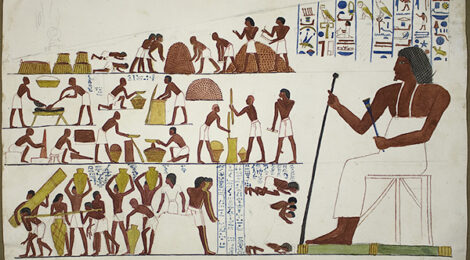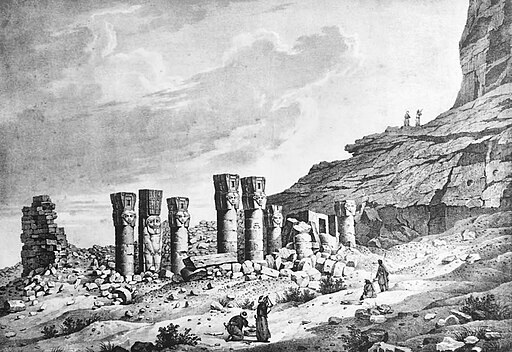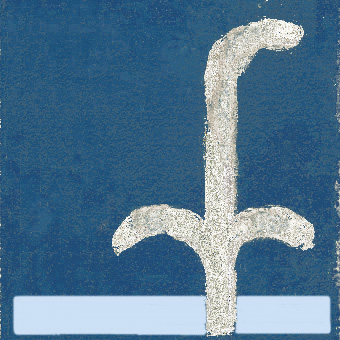
George A. Hoskins (1802-1863)
George A. Hoskins (1802-1863) was a trained barrister, writer, and traveler who visited Egypt and Nubia during the early 1830s and again in the 1860s. As a result of his initial visit to Egypt he published two volumes, one of which is entitled: Travels in Ethiopia, above the second cataract of the Nile; exhibiting the state of that country, and its various inhabitants, under the dominion of Mohammed Ali; and illustrating the antiquities, arts, and history of the ancient kingdom of Meroe (London: Longman et.al., 1835). This was written shortly after Hoskins’ travels in 1832-1833 which included visits to sites in northern Sudan and was illustrated with selected watercolours and drawings created by commissioned artist Luchese Bandoni. These images provide incredible insights into the landscape of key ancient sites, while also demonstrating Bandoni’s technical skills; for example, several sketches were completed during Hoskins’ visit to the large temple of Amun at Gebel Barkal – described by Hoskins as the ‘Typhonium’, today this structure is associated with the 25th Dynasty pharaoh Taharqa and designated as temple B300. These two images of the same space not only provide a contrast in the medium used, but in the way in which the ruins of the temple have been presented.
Both the pencil drawing (Hoskins MSS 2.32) and watercolour (Hoskins MSS 2.35) show the same view of the temple, but the watercolour removes much of the rubble strewn across the ground and fills this space with two groups of standing figures, providing a sense of the scale of the large Hathor-headed columns behind them. In the watercolour, the facial features of Hathor are more clearly defined, and the Bes-column on the left side is particularly prominent and identifiable. This is an important feature to have been recorded at this early date, as today many of the columns within the outer court are no longer in place (though a Bes fragment is now in the Gebel Barkal Museum collection). These images were also not the first to have been sketched of the site, but are closely paralleled by the image featured in the 2nd volume of French traveller Frédéric Cailliaud’s publications on his travels in Meroe, which also provides these same crucial details about the surviving temple architecture.

Hoskins’ later volume is entitled Visit to the great oasis of the Libyan desert; with an account, ancient and modern, of the oasis of Amun, and the other oases now under the dominion of the Pasha of Egypt (London: Longman et.al., 1837), and again beautifully detailed sketches bring some of his descriptions of sites to life. A number of pencil drawings capture various sites across the Kharga oasis area in the western desert of Egypt, such as this view of the gateway to the temple of Amun at Hibis (Hoskins MSS 1.12). This was an incredibly important site, not only as one of the most well-preserved temples in the Kharga area today but also as a temple space with crucial evidence of architectural developments and relief scenes dating to the Persian occupation of Egypt (525-404 BCE). Such drawings also provide a sense of the temple’s condition in the 1830s, and this is also valuable as it would be many decades before an excavation of the site was begun by Herbert Winlock on behalf of the Metropolitan Museum of Art in 1909.
In addition to capturing images of the wider geographical area, Hoskins also recorded relief scenes in various temple and tomb contexts. Importantly, he is also one of the earliest accounts written in English to be recording such Egyptian sites and scenes, while contemporary travelers like Cailliaud -but also key figures who were actively studying the ancient Egyptian language such as Champollion -were writing in French. Several meticulously detailed pencil drawings from Hibis temple show the astronomical scenes found carved across the western wall of the sanctuary featuring rows of various divine figures; there is also a clear attempt to identify some of these deities as handwritten labels for several gods and their iconography include ‘bird with legs of a man’, ‘tiger’, and ‘on pedestal’ (Hoskins MSS 1.8). This provides an interesting contrast to the formal Egyptological publications of the temple decoration completed over 100 years later by Norman de Garis Davies in the 1950s (Volume III: Pl. 2-6, see especially Pl. 3 for comparison to this Hoskins’ image).
A series of mounted watercolours record relief scenes from various tombs, and these help to capture the once vibrant colours used to decorate the tomb walls. There are 15 examples of watercolours that record relief scenes from the Theban tomb of a high-status official named Rekhmire (Theban Tomb 100). These mostly show scenes from the passageway area, including several large registers of offering-bearers and workers preparing provisions while a much larger seated Rekhmire observes (Hoskins MSS 1.17). The colours reflect some of the original paint still intact across the wall, particularly the ochre colour used for the skin of the male figures and the yellow used for the various vessels and furniture, but also the miscellaneous colours used for the hieroglyphic text above Rekmire.
As well as the elite tombs, Hoskins’ collection includes images inspired by relief scenes from royal tombs from the Valley of the Kings. This includes various scenes from the tomb of Ramesses III (KV11), which by the time of Hoskins’ travels to Egypt had been accessible as early as the 1730s, and work on mapping the tomb and recording epigraphical details had been underway even before the Napoleonic expeditions in 1799. Key figures like Giovanni B. Belzoni, James Burton and Robert Hay subsequently visited and studied the site during the earlier phases of the 1800s, and only a short period after Hoskin’s travels further epigraphical work was also carried out by Karl R. Lepsius in the 1840s. While the artist’s work may have been inspired by observing the real tomb spaces, in other instances there may have been other outside influences to the way in which certain scenes have been portrayed.
This watercolour shows two harpists (hence the alternative name for this space as the ‘Harper’s Tomb’), which was originally carved within a side room in close proximity to the king’s burial chamber. Both play the instrument and wear the same clothing while also adopting similar poses (Hoskins MSS 3.38). But here the full relief scene hasn’t been accurately rendered, as in the tomb itself the harpists are actually shown playing before two different deities; one before the god Onuris-Shu and the other before the god Re-Horakhty. Here in Hoskins’ watercolour, the focus is only on the harpists.
Hoskins’ watercolour may have been at least partly inspired by other images that were circulating at the time, for instance an illustration from the 1818 publication Description de l’Egypte ou Recueil des observations et des recherches qui ont été faites en Égypte pendant l’expédition de l’Armée française, publié par les ordres du Gouvernement Antiquites planches Tome Second shown below, which includes the deities but also uses exaggerated colours and uses the negative space on either side of the page to include other separate illustrations. But even earlier epigraphical work carried out by James Bruce (1730-1794) in the 1760s included a black and white engraving of the harpists which was included in his Travels to discover the source of the Nile, in the years 1768, 1769, 1770, 1771, 1772, and 1773. Vol. I publication from 1790, and this too could also have inspired Hoskins’ image. Though others also chose to replicate the harpists in this same way, as a French Egyptologist named Émile Prisse d’Avennes (1807-1879) also included a very similar reproduction in his Histoire de L’Art Égyptien d’après les monuments, depuis les temps les plus reculés jusqu’à la domination romaine. Hoskins’ watercolour is also interesting in that despite earlier publications that included fuller renderings of the hieroglyphs, here they are outlined in very faint pencil. It also includes the note ‘G.A. Hoskins’ at the bottom left corner of the paper – this is not the case for many of the images in the collection, and it’s notable that it’s included here. Furthermore, while damage to several parts of the relief scene is recorded, including a lower portion of the harp and the face of one of the musicians, today the tomb scene looks incredibly different and much of these scenes are now entirely lost. This is mostly due to flooding damage that took place between 1885-1914, so much later than Hoskins’ lifetime. More recent images of the tomb can be found on the Theban Mapping Project website to compare with these watercolours.

There are almost 400 drawings, watercolours and squeezes within the Hoskins MSS collection that are now in the Griffith Institute, and we are continually working on moving all of the online records of Hoskins’ material onto our online catalogue, as well as on our website, and you can find links to these resources listed below.
Sources:
- Author unknown. ‘The Met Around the World: Temple of Hibis, Kharga Oasis’: https://artistproject.metmuseum.org/met-around-the-world/?page=10149
- F. Cailliaud (1827). Voyage à Meroë : au fleuve Blanc, au-delà de Fazoql dans le midi du royaume de Snnâr à Syouah tc. Volume II.
- N. de Garis Davies (1953). The Temple of Hibis in El Khārgeh oasis: Part III, the decoration. New York; Publications of the Metropolitan Museum of Art Egyptian Expedition, v. 17.
- Hoskins MSS from the Griffith Institute © Griffith Institute, University of Oxford, available online at: http://www.griffith.ox.ac.uk/gri/4hoskins_opening_page.html https://archive.griffith.ox.ac.uk/index.php/hoskins-collection
- R. G. Morkot (2013). ‘George Hoskins, Travels in Ethiopia and the History of Meroe’, in D. Fortenberry (ed.) Souvenirs and New Ideas: Travel and Collecting in Egypt and the Near East. Oxford; Oxbow.
- For the Theban tomb of Rekhmire, see the resources on Osirisnet: https://www.osirisnet.net/tombes/nobles/rekhmire100/e_rekhmire100_05.htm
- For the royal tomb of Ramesses III in the Valley of the Kings, see the Theban Mapping Project website: https://www.ramesses-iii-project.com/english/the-project/









